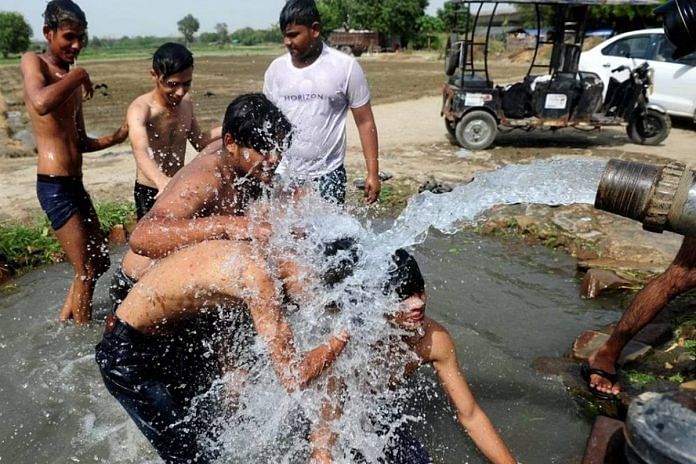New Delhi: While the India Meteorological Department has warned of the approach of a severe summer with “above normal” temperatures and heatwaves across the country between March and May, heat action plans (HAPs) of 18 states are “underfunded, insufficiently transparent and not built for the local context”, the Centre for Policy Research (CPR) has warned in its “first critical review” of 37 such plans, released Monday.
Titled ‘How is India Adapting to Heatwaves?: An assessment of heat action plans with insights for transformative climate action’, the report is based on the think-tank’s analysis of HAPs across 18 states from 2017 onwards — nine at the city level, 13 at the district and 15 at the state level — and concludes that the framework to tackle extreme heatwaves in India was failing in “identifying and targeting vulnerable groups”.
By July last year, India had already experienced five times more heatwaves than in the previous year, the Ministry of Earth Sciences had revealed. The IMD defines heatwaves as conditions when the maximum temperatures in the plains reach 40 degrees Celcius or more. In hilly regions, the heat wave threshold is 30 degrees Celcius or more.
The Union health ministry last month issued a national action plan to states and union territories on handling heat-related illnesses for the coming summer season.
The HAPs reviewed by the CPR are implemented by governments at the state, district, and municipal levels, and serve as guidance documents to help prepare for, respond to, recover and learn from heat waves. The objective is to alert people living in vulnerable regions, who are at risk of heat-related illness, where extreme heat conditions either exist or are imminent, the report said.
Although the exact number of HAPs being implemented in the country is yet to be collated, said the CPR report, it’s estimated that there are well over 100 such plans in action.
The report assessed HAPs on 22 criteria, divided across four broad categories — hazard definition, who is most exposed, what solutions are discussed, and adaptation planning/outcomes.
The study revealed that of the 37 HAPs which were reviewed, only 11 discussed funding sources, of which eight asked implementing departments to self-allocate resources.
“We propose systematically mapping HAP interventions against existing state and central schemes to unlock funding,” the Delhi-based think-tank said in its report.
On the issue of transparency, the CPR report pointed to the lack of a national repository of HAPs, as very few were listed online.
“It is unclear whether these HAPs are being updated periodically and whether this is based on evaluation data. We recommend creating a national repository of HAPs housed in the National Disaster Management Authority (NDMA) and conducting independent, publicly accessible external evaluations of their performance,” it highlighted.
Also read: What are wet bulb temperatures, and why they probably won’t cross 35°C long enough to be lethal
‘Not built for local context’
Most of the action plans reviewed were not built for local context, stated the report. It also pointed out that they have an “oversimplified view” of the heatwave hazard.
“Only ten out of 37 HAPs reviewed seem to establish locally-defined temperature thresholds though it is unclear whether they take local risk multipliers (such as humidity, hot nights, duration of continuous heat among others) into account to declare a heatwave,” the assessment stated. These 10 include Ahmedabad, Arunachal Pradesh, Bhubaneswar, Chandrapur, Kerala, Nagpur, Odisha, Rajkot, Surat, and Vadodara.
It also found that nearly all HAPs are poor at identifying and targeting vulnerable groups.
“Only two (Bhubaneshwar and Rajkot) of 37 HAPs explicitly carry out and present vulnerability assessments. This leaves the implementer with little data on where to direct their scarce resources and could lead to poor targeting,” the report stated.
Apart from these analyses, the CPR report also pointed out how India’s HAPs have “weak legal foundations” as none of the action plans indicates the “legal sources of their authority”.
“While this is not necessary for plans, it reduces bureaucratic incentives to comply with HAP instructions, which is significant in the context of understaffed and overburdened implementation agencies tasked with simultaneously implementing several other long-term plans,” the report noted.
‘NDMA, IMD working with 23 vulnerable states’
The CPR report comes at a time when India is facing more intense and frequent heat waves. Earlier this year, the country experienced its hottest February since 1901, with the average maximum temperature touching 29.54 degrees Celsius, according to the meteorological office.
According to a The Lancet report published last year in October, exposure to heat caused a loss of 167.2 billion potential labour hours in India in 2021, resulting in loss of incomes equivalent to about 5.4 per cent of the country’s GDP. Deaths also increased by 55 per cent. According to media reports, India reported 20,000 heat-related deaths in adults over the age of 65 annually between 2000 and 2006. The number increased by 31,000 deaths from 2017 to 2021.
The World Bank too, in a report titled “Climate Investment Opportunities in India’s Cooling Sector” published in November last year, had cautioned that India could experience heatwaves that break the “human survivability limit”.
According to this report, the country is experiencing higher temperatures that arrive earlier and stay far longer. It warned that the heat waves would be devastating for many poor and marginalised population.
In a written reply to the Lok Sabha Monday, Union Minister of State (MoS) for Environment, Forest and Climate Change, Ashwini Kumar Choubey, said that the central government has taken steps to make the public aware of health impacts due to climate change, including heat waves.
Choubey added that in order to support heat action plans in the country, the National Disaster Management Authority (NDMA) and IMD are jointly working with 23 states prone to extreme high temperatures.
(Edited by Poulomi Banerjee)
Also read: Heatwave in India this year was 30 times more likely due to climate change, Lancet study says






